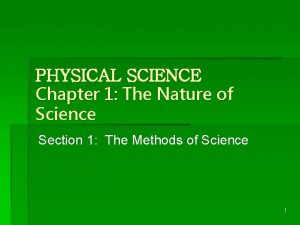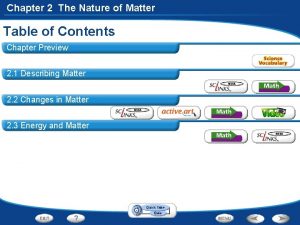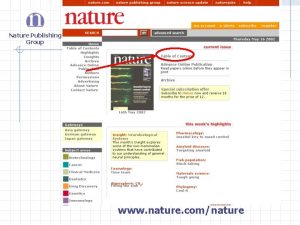Chapter 11 Heat Nature of Heat Heat is















- Slides: 15

Chapter 11 Heat

Nature of Heat �Heat is the transfer of energy (every in transit) from one body to another due to the temperature difference between the two bodies. When the body absorbs the heat, its internal energy increases and when it losses heat, its internal energy decreases. �Temperature: �Definition: �“Temperature is the degree of hotness or coolness of a body “. �OR �“The measurement of average translational kinetic energy of the molecules is called temperature “.

Thermometer � An instrument which is used for the measurement of temperature is called the nanometer. Any property of a substance which changes uniformly with temperature can be used to measure the temperature. � Temperature scales: � The three scales commonly used to measure the temperature are: � i. Centigrade or Celsius scale. � ii. Kelvin’s or absolute scale. � iii. Fahrenhelt scale. � 1. Centigrade or Celsius scale, in the melting point of ice is taken as 0 o. C and boiling point of water is taken as 100 o. C. The interval between them is divided into 100 equal parts. Each part is called one degree centigrade which is written as 1 o. C. � 2 The lowest temperature which can be reached is – 273 o. C. This temperature is taken 0 o. C on Kelvin’s scale. The size of the degree on the scale is also same as that on centigrade scale. � 3 In Fahrenheit scale, the melting point of ice is taken as 32 o. C and boiling point of water is taken as 212 o, and the internal given then is divided into 180 parts. Each part is called one degree. Fahrenheit which is written as 1 o. F.

Scale

Inter Conversion of Scale � The conversion of temperature in centigrade (Tc) into the temperature in Kelvin (Tk) is � performed by the relation. Tk = Tc + 273 OR Tc = Tk - 273 Temperature in Fahrenheit (Tf) is converted into temperature in centigrade (Tc) by the formula. Tf = 9 / 5 (Tc) + 32 Tc = 5 / 9 (Tf – 32 ) Ordinary Liquid in Glass Thermometer: It consist of a glass slem with a capillary tube having a small bulb at one end. The bulb end part of the capillary tube is filled with liquid (mercury or alcohol). The upper end of the capillary tube is sealed to prevent the liquid from evaporation. Air is reserved from the upper end before sealing , when the bulb is sealed , the mercury expands and rise in the capillary tube. The stem is calibrated in degrees to measure the temperature. The thermometer used in the laboratory has a range from – 10 oc to 110 o. C

Clinical thermometer � Clinical thermometer is used to measure the temperature of human body. The normal body temperature is about 98. 4 o. F. The bulb of thermometer is placed under the tongue to measure the temperature of a body. The clinical thermometer has a narrow bend or construction in its capillary tube bore near the bulb to prevent the mercury level from falling when the bulb is removed from the patient’s mouth.

Maximum and Minimum Thermometer � The purpose of this thermometer is to read maximum and minimum temperature reached over a period of time. It consist of a bulb A continuously alcohol is connected through a U shaped tube from B to C (containing mercury) to a second bulb D nearly full with alcohol. Above D, the space is evacuated. Left limb of Ushaped tube is calibrated according to the expansion of alcohol in AB. The right limb of U-tube is also calibrated. So that both mercury surfaces point to the same member. If mercury in AB contracts, the pressure in CD well drive the mercury back. On each mercy surface, there is a small iron index provided with a spring. Due to fall in temperature the alcohol in A contracts and the left index moves up and is left there. Due to rise in temperature, the alcohol in A expands and the right index moves and is left there. The lower end of left index gives minimum temperature and the lower end of right index gives maximum temperature over a period of time. The indices are brought in contact with mercury by using small bouquet.

Transfer of Heat �There are three ways by which heat is transferred from one place to another. They are �i. Conduction. �ii. Convection. �iii. Radiation.

Conduction �“The process in which heat is transferred from one place to another by the vibration and collision of molecules or atoms, called conduction. ” �Explanation: �When the heat is provided to one end of the heat conductor. Its temperature rise which increase the kinetic energy of the molecules. Due to increase kinetic energy, molecules start vibration with greater amplitude and make collision with neighboring molecules. This collision causes the transference of energy from molecule to molecule. In this way that is transferred from one end to other. �Example: �Solid heat conductor transfer heat by the process of conductor.

Convection �The process, in which heat is transferred from one place to another by the actual motion of molecules, is called convection. Since the molecules of liquids and gases are free to more, therefore in liquid and �gasses heat is transferred from one place to another by convection. �Example: �In fluid (liquids and gasses) heat is transferred by the process of convection.

Radiation �The process in which heat is neither transferred by the vibration and collision neither of molecules, nor by the actual motion of molecules but it is transferred without any material medium, is called Radiation. �In this process hot body radiates energy in the form of electromagnetic waves. �Heat reaches from sun to earth, by radiation.

Thermos Flask � It is used to maintain constant temperature. A thermos flask consists of a double walled glass. The inner surface of the outer wall and the outer surface of the inner wall are polished (silvered). The space between to the two walls is evacuated and then sealed. The vacuum between the two walls reduces the probability of transfer of heat by conduction and convection.

Thermal Conductivity � The ability of a substance to conduct heat energy is called thermal conductivity. Consider a metal block of length L and the cross section area A, Such that it one end is constantly maintained at lower temperature T 1 and other end at a higher temperature T 2. If Q heat is conducted from hot end to the cold end in � t second, then it is found that. � Heat is proportional to the cross sectional area

Thermal Expansion � Increase in the size of the object due to heat is called thermal expansion. � Thermal Expansion in Solid: � When solid is heated its temperature rises and its molecules start vibrating with greater amplitude. Due to this, the average distance between the molecules increases and the solid expands. � There are two expansions in solids. � i. Linear thermal expansion. ii. Volumetric thermal expansion. � Linear Thermal Expansion: � Definition: � “ Increase in the length of the rod due to heat is called linear thermal expansion. ” � Consider a metal rod having length L, when the temperature is increased by delta T , let the increase bedelta T.

Mathematical Where “ “ is the coefficient of linear expansion. It can be written as: It shows that, change in length per unit length per degree rise in temperature is called coefficient of linear expansion. Consider
 Nature and nature's laws lay hid in night
Nature and nature's laws lay hid in night Determinace lidské psychiky
Determinace lidské psychiky Powerpoint
Powerpoint Nature nurture and human diversity
Nature nurture and human diversity Chapter 9 section 1 the nature of interest groups
Chapter 9 section 1 the nature of interest groups Chapter 1 the nature of strategic management
Chapter 1 the nature of strategic management Chapter 10 lipids nature's flavor enhancers answers
Chapter 10 lipids nature's flavor enhancers answers Chapter 4 section 1 the nature of energy worksheet answers
Chapter 4 section 1 the nature of energy worksheet answers Nature of nurture chapter 3
Nature of nurture chapter 3 Nature of science chapter 1
Nature of science chapter 1 Chapter 8 lesson 1
Chapter 8 lesson 1 Non examples of homogeneous mixture
Non examples of homogeneous mixture Chapter 4 basic food chemistry the nature of matter
Chapter 4 basic food chemistry the nature of matter Chapter 4 basic food chemistry the nature of matter
Chapter 4 basic food chemistry the nature of matter The nature of matter chapter 2
The nature of matter chapter 2 Nature of nurture chapter 2
Nature of nurture chapter 2





























